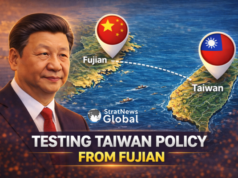
A day before the two-day NATO Summit began at The Hague July 24, President Donald Trump publicly shared private messages from NATO Secretary General Mark Rutte in which the Alliance’s top official praised Trump’s “decisive action” on Iran and credited him for making European allies “spend BIG” on defence.
The messages, confirmed by NATO, sent a clear signal: Trump’s scorched-earth diplomacy may be erratic, but it’s undeniably effective. He has bullied, berated, and belittled NATO allies—and forced them to do what they had long resisted: take responsibility for their own security.
But this newfound urgency masks a deeper crisis. When Trump’s Secretary of Defence told NATO in February 2025 that Washington would “no longer tolerate an imbalanced relationship,” European allies were left staring into a $1 trillion abyss.
That’s the staggering price tag the International Institute for Strategic Studies (IISS) now estimates it would cost for Europe to replace American military muscle if the U.S. were to walk away from NATO.
The scenario outlined in the IISS report—Defending Europe Without the United States: Costs and Consequences, released in May—is grounded in recent reality: Trump’s disdain for alliances, America’s pivot to the Indo-Pacific, and Europe’s own sluggish defence posture have made the prospect of a NATO sans America plausible, if not probable.
The IISS assumes a ceasefire in Ukraine by mid-2025 and a gradual U.S. pullout from NATO. Within two years, Russia could have reconstituted enough of its forces to pose a serious threat to the Baltics. Despite battlefield losses, its air and naval capabilities remain largely intact. With its economy on a war footing and defence spending rising to a projected 7.5% of GDP in 2025, Moscow could regain first-mover advantage by 2027.
The Kremlin is clearly preparing for round two. But what about Europe? The answer, for now, is a grim shrug.
NATO’s European members currently rely heavily on U.S. command-and-control systems, ISR (intelligence, surveillance, and reconnaissance), and over 128,000 American troops. Replacing all that would mean not just filling military gaps, but rebuilding entire capabilities—in the air, on land, at sea, and in space.
According to the IISS, Europe would need:
- 400 new fighter jets
- 600 main battle tanks
- 20 destroyers
- 10 nuclear-powered attack submarines
- Dozens of missile systems, helicopters, and surveillance aircraft
- Vast ISR infrastructure and command headquarters
The cost? An eye-watering $1 trillion over 25 years—and that’s just for conventional capabilities. Nuclear deterrence, cyber defence, and strategic leadership? Not even counted.
Europe may talk a good game about strategic autonomy, but the defence industrial base tells another story. Production lines are limited, naval shipyards have closed, and skilled labour is scarce. While land systems could be scaled up within a decade, the air and maritime sectors—where the U.S. footprint is largest—are far less ready.
Even optimistic projections show Europe unable to match U.S. capabilities in the air and at sea for at least ten years, and only then with serious investment, political will, and multilateral coordination—all of which remain patchy at best.
Could Europe raise the money? Technically, yes.
With defence spending already up 11.8% in 2024 and EU proposals like “ReArm Europe” aiming to mobilise €800 billion, the money exists. But the politics? Much murkier. National debt brakes, competing social priorities, and political resistance—especially in Southern Europe—make sustained defence spending hikes a tough sell.
Moreover, temporary EU fiscal leeway runs out by 2029, leaving a short runway for long-term investment. And while calls for defence bonds and joint borrowing grow louder, consensus remains elusive.
What’s most sobering in the IISS report is the window of vulnerability. If the U.S. begins withdrawing in 2025 and Russia rebuilds by 2027, Europe faces a dangerous strategic gap—two to five years of exposure without sufficient deterrence.
During this time, European policymakers would face excruciating trade-offs: Do they buy time by sourcing weapons from abroad (read: the U.S. again)? Or do they invest in slow, domestic capacity-building and hope Moscow doesn’t test NATO’s Article 5?
Some are hedging bets. French President Macron has floated the idea of extending France’s nuclear umbrella. Germany is boosting defence spending. The EU is scrambling to build procurement frameworks. But the scale of the task remains daunting.
The IISS doesn’t declare the end of NATO. But it does make clear that the Alliance’s European flank cannot survive in its current form if America walks.
If Europe wants strategic autonomy, it must pay for it—not just in euros, but in speed, unity, and sacrifice. Otherwise, the next time Russian tanks threaten the Baltics, Brussels may find itself with a plan but no planes. A strategy, but no ships. A cause, but no commander.
Europe has spent decades under the comfort of the American umbrella. That umbrella is now closing—and Donald Trump is holding the handle.
In a career spanning three decades and counting, Ramananda (Ram to his friends) has been the foreign editor of The Telegraph, Outlook Magazine and the New Indian Express. He helped set up rediff.com’s editorial operations in San Jose and New York, helmed sify.com, and was the founder editor of India.com.
His work has featured in national and international publications like the Al Jazeera Centre for Studies, Global Times and Ashahi Shimbun. But his one constant over all these years, he says, has been the attempt to understand rising India’s place in the world.
He can rustle up a mean salad, his oil-less pepper chicken is to die for, and all it takes is some beer and rhythm and blues to rock his soul.
Talk to him about foreign and strategic affairs, media, South Asia, China, and of course India.




